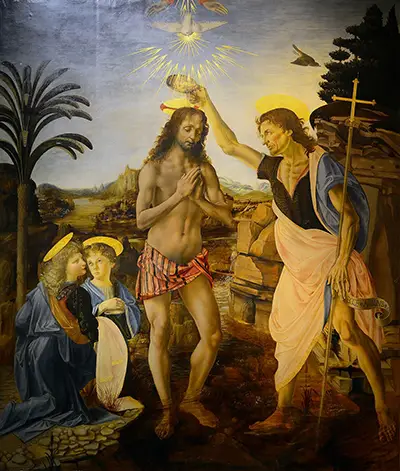It was commissioned by the monks of San Salvi near Florence, is a painting attributed to the studio of the Italian Renaissance painter Andrea del Verrocchio and is quite generally accredited to him, and his vivacious pupil Leonardo da Vinci.
The painting vibrantly depicts of the Baptism of Jesus by John the Baptist, as recorded in the Gospels of Matthew, Mark, and Luke.
John the Baptist is observed gently pouring water over Christ’s head. God’s hands outstretched coming down from the sky, a dove descending his arms symbolizing of the Holy Spirit.
With radiant beams of light streaming from his glory all cautiously blending into the canvas well-encapsulated embodying of the divinity of Christ, as well as acknowledging his unison as part of the Holy Trinity.
Additionally, Jesus is placed at the center of the masterpiece, with his hands enclasped in a praying position, exemplifying of his grace and humbleness.
Leonardo was 23 years old at that time, and the angel to the left is documented as having been painted by this young apprentice, a fact of which has caused so much excitement and called forth discussions; so much special commentary and mythology.
Modern critics further attribute that much of the striking landscape in the background of the painting, as well as, the figure of Christ to Leonardo da Vinci’s touch too. Of the four figures illustrated in the painting, one angel (the one holding Christ’s clothes), stands out significantly better than the others.
Leonardo stands out, with his contribution being the angel holding the Mantel, the Kneeling figure illustrates of attributes that Leonardo da Vinci would retain, and carefully develop throughout the rest of his Art Career.
Particularly the exotic luminous tumbling locks of hair carefully washed brightness in the eyes, plus that sweet look or sense of humor conveyed on the face. Even the turf of grass at the angel’s knee voices of his interest to come in all facets of nature.
The painting also has a story to it. It is said that after taking a look at Leonardo’s angel touch, Verrocchio never again ever wanted to raise a brush, he felt so ashamed and humiliated; for how could an apprentice’s touch be far much superior to his, it was from this that he swore to never again ever touch color.
Although this story might be something more of an old chestnut, it might also to be true to a certain degree, for it is true that this is the last known painting accredited to the Italian Renaissance painter Andrea del Verrocchio.
An x-ray of this painting discloses that the original sketching for the angel that Verrocchio did for Leonardo is entirely different from the final result set forth. This further exemplifies of da Vinci’s ingenuity, for even at this early stage he already was freeing himself from his master’s confines and following down his now own path.
Taking a close look and comparison of the two angels; we get to see that Leonardo pays closer attention to the main event in the painting.
With his angel looking natural and part of the on-going activities, in contrast to Verrocchio’s angel of whom stares off into space, with no interest whatsoever in what is going on, perhaps it wouldn’t be too blunt or bold, to say the angel looks bored.
Additionally, the draperies on Leonardo da Vinci’s angel incorporates a rather curious system of folds which graciously fit in perfectly in with the occasion. But that’s not all; it has also been pointed out that Leonardo retouched the hair on the second angel, as well as, contributed in creating the astounding background; by painting the area located directly above the angel’s heads.
Verrocchio’s painting style was very much traditional for that time, the distant plains, hills encroached with formalized rocks as well as scattered trees feel somewhat plastic and not very engaging, while Leonardo da Vinci’s work on the other already showed great promise and originality with water, sunlight, shadow, and mists.
The angel and Leonardo’s part in touch to the landscape are painted in oil. This was a new medium and revolutionary approach in painting introduced in Italy during this period. Verrocchio’s portions of this masterpiece are executed through the use the Traditional Egg Tempera, which produced a surface somewhat similar to enamel, but afore demanded strict demarcation line between the color contrasts.
It goes without saying that it was rather too typical and expected of Leonardo to fully embrace and cultivate on the newly introduced medium in the Art industry, while his master, the Italian Renaissance painter Andrea del Verrocchio, continued using the old.


